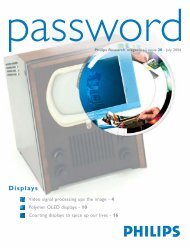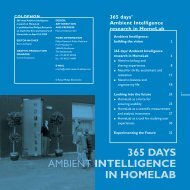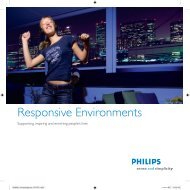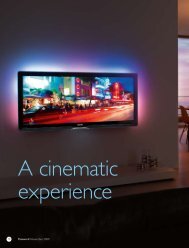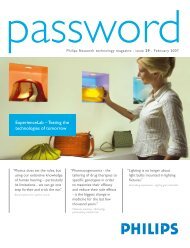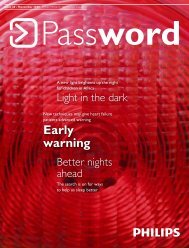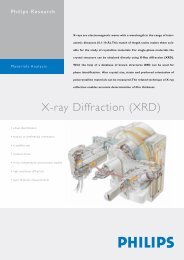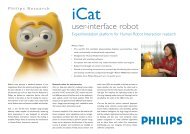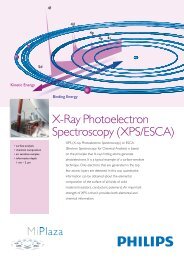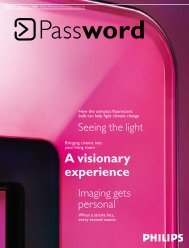article - Philips Research
article - Philips Research
article - Philips Research
You also want an ePaper? Increase the reach of your titles
YUMPU automatically turns print PDFs into web optimized ePapers that Google loves.
OMC reference<br />
architecture<br />
Application<br />
Plugin<br />
Application<br />
Plugin<br />
OMC framework<br />
OMC Middleware API<br />
Communication<br />
...<br />
Database<br />
Media player<br />
Graphics<br />
Application<br />
Plugin<br />
AV API + OS API<br />
AV Streaming Linux OS<br />
Audio<br />
Figure 1<br />
Overlay<br />
Video<br />
Storage<br />
Network<br />
CPU<br />
OMC Application Plug-ins<br />
OMC framework<br />
Required Support Libraries<br />
AV Streaming Platform<br />
Basic OS Functionality<br />
Open source and proprietary software in harmony<br />
An example of where <strong>Philips</strong> has incorporated its proprietary software<br />
alongside open-source middleware (in this case Linux) is its Active Block<br />
I/O Scheduling System (ABISS). This technology – which essentially enables<br />
real-time hard disk access at low power for reliable data intensive streaming<br />
(e.g. high-density video) – will be critical to ensure a media center can provide<br />
seamless broadcast capabilities. Particularly when asked to<br />
multi-task due to access requests made by other applications and users<br />
during operation.<br />
The ABISS system architecture is shown in fi gure 2. A set of modifi cations<br />
to the Linux kernel provides the basic ABISS framework. The scheduler itself<br />
can be implemented as a Loadable Kernel Module, which interfaces with the<br />
framework using the standard Linux module interface. <strong>Philips</strong> wanted to<br />
allow any application to use the ABISS functionality and allow third parties<br />
to provide proprietary schedulers with the ABISS framework, while protecting<br />
the IPR in its own scheduler.<br />
Main <strong>article</strong> media centers Main <strong>article</strong> media centers<br />
alongside major applications from established vendors), as illustrated in fi gure 1 on the left.<br />
<strong>Philips</strong> already has a number of proof-of-concept applications where proprietary solutions run<br />
on open-source software such as Linux in a commercially protected product. Examples are the<br />
Linux OS-based Nexperia STB810 system solution (see box ‘The ‘mythical set-top box’) and<br />
the ABISS system architecture (see box ‘Open source and proprietary software in harmony’.<br />
Both products adapt low-cost, open-source Linux software from the PC world to fi t the needs<br />
of the CE space without sacrifi cing intellectual-property right (IPR) protection. Such an ‘open<br />
source’ and CE alignment could prove invaluable to the development of a true media center,<br />
whether a Linux or proprietary OS was used.<br />
The global aim would be to produce a single, modular, standard platform that really does offer<br />
the best of all worlds (which will be crucial to consumer acceptance). This would be able to<br />
support each individual company’s proprietary solutions as almost ‘plug-in’ type products that<br />
will have gradually migrated over time from their standalone contemporary cousins.<br />
For its part, <strong>Philips</strong> has already developed some illustrative plug-in software applications<br />
designed to customize the output of a media center (whether existing or in the future) to suit<br />
an individual’s precise needs. (See box “Your personal Clint Eastwood Channel”.)<br />
Protecting IPR<br />
Despite the optimism, turning the Open Media Center vision into a reality in the fi ercely<br />
competitive world of consumer electronics won’t be easy or risk-free. There will be enormous<br />
competitive constraints; chief among which is how CE fi rms will protect their intellectualproperty<br />
rights (IPR) within such a vast and far-reaching, essentially software-based program.<br />
“One way an Open Media Center could approach this is by breaking down the application into<br />
a common middleware platform upon which customized and IPR protected proprietary plug-in<br />
applications can be supported,” explains Arnoud Engelfriet, a patent attorney and IPR specialist<br />
within <strong>Philips</strong> Intellectual Property and Standards (IP&S).<br />
Application Library Daemon<br />
Linux<br />
kernel ABISS<br />
Scheduler<br />
Policy 1<br />
Policy 2<br />
Figure 2<br />
“What format the common middleware – i.e. joint development software stack – would take,<br />
would have to be carefully considered. That said, the joint development model would in my<br />
opinion be entirely capable of supporting a robust IPR protection mechanism for the plug-ins,”<br />
Engelfriet adds. “The challenge would be ensuring that this IPR plug-in mechanism maintained<br />
a properly secure distance between the open and proprietary components, but did not inhibit<br />
their ability to freely communicate with the middleware during operation.”<br />
“ Industry collaboration is the only viable way forward to migrate<br />
existing product offerings into a harmonized, universal solution. ”<br />
Frank van Tuijl, <strong>Philips</strong> <strong>Research</strong>,<br />
Chasing the big prize<br />
In the longer term, <strong>Philips</strong> believes the Open Media Center vision is a viable way for the CE<br />
market to meet market expectations for what next-generation, universal media center<br />
solutions could and should be. While it does not intend to aggressively thrust the concept on<br />
the world’s major CE vendors, it does intend to begin tentative discussions and to highlight why<br />
it would be the best solution for CE.<br />
“According to our research, 80 percent of the profi ts from a next-generation open media<br />
center product would come from the plug-ins,” says van Tuijl. “This means companies could<br />
concentrate their product differentiation efforts there, while minimizing commercial risk on the<br />
middleware by collaborating. There would be absolutely no competitive advantage for any fi rm<br />
to develop the middleware on its own.”<br />
“This means the Open Media Center concept is about as perfect a win-win for CE companies<br />
and consumers as can be expected in the real world,” summarizes Kaashoek. “It will create the<br />
kind of competition that will drive the on-going development of continually improving and new<br />
innovative applications, but at the same time give consumers enormous choice and value. This<br />
means the CE fi rms get access to what could be the largest consumer electronics market the<br />
world has ever seen, at a migratory pace that is technically achievable and commercially low<br />
risk, and in a way that will give consumers ever widening access to products that exactly meet<br />
their needs at a price level they can afford. That is what the <strong>Philips</strong> Open Media Center vision<br />
is all about.”<br />
Frank van Tuijl l <strong>Philips</strong> <strong>Research</strong> l frank.van.tuijl@philips.com<br />
Extra info www.research.philips.com/password l media centers l open invention network<br />
Your personal ‘Clint<br />
Eastwood’ channel<br />
Imagine how compelling it would be<br />
for Clint Eastwood fans if their media<br />
center could scan the channels for<br />
Clint’s fi lms and collate them into a<br />
special ‘Clint Eastwood Channel’.<br />
With the <strong>Philips</strong> Flexchannels plug-in<br />
– designed to run on an open, Linux<br />
OS-based media center – they could do<br />
just that. Flexchannels is a way to create<br />
personalized TV channels.<br />
The system records the TV content that<br />
matches the profi le of the user-defi ned<br />
channel (e.g. “fi lms starring or directed<br />
by Clint Eastwood”), creates a sequence<br />
for replay, and deletes content when it<br />
has been viewed. It is also possible to<br />
supplement the recorded material with<br />
on-demand content.<br />
Other illustrative plug-ins for the Open<br />
Media Center include ‘Distributed<br />
Collaborative Recommender’ and<br />
‘Movie-in-a-Minute’. The Recommender<br />
gathers personal TV program ratings<br />
from users around the world using a<br />
technique called ‘collaborative fi ltering’<br />
and suggests personalized<br />
recommendations from users with<br />
similar viewing profi les. Movie-in-a-<br />
Minute is an automatically generated<br />
short preview of a recording. It helps<br />
the user to select a program by showing<br />
sample video fragments in a quick and<br />
entertaining way.<br />
10 <strong>Philips</strong> <strong>Research</strong> Password 26 l February 2006 <strong>Philips</strong> <strong>Research</strong> Password 26 11<br />
l February 2006





